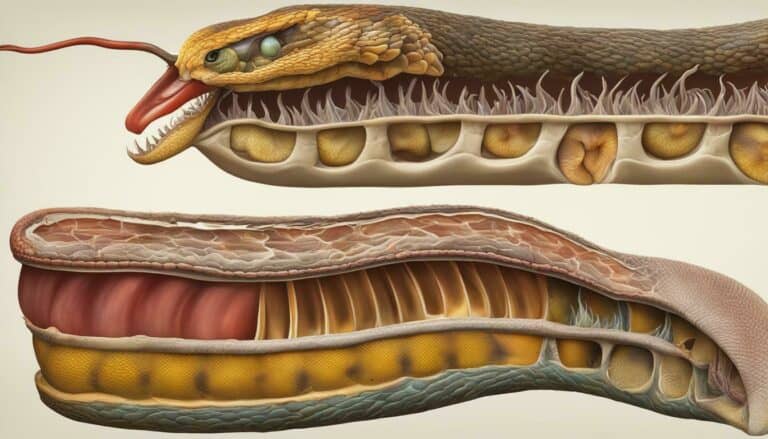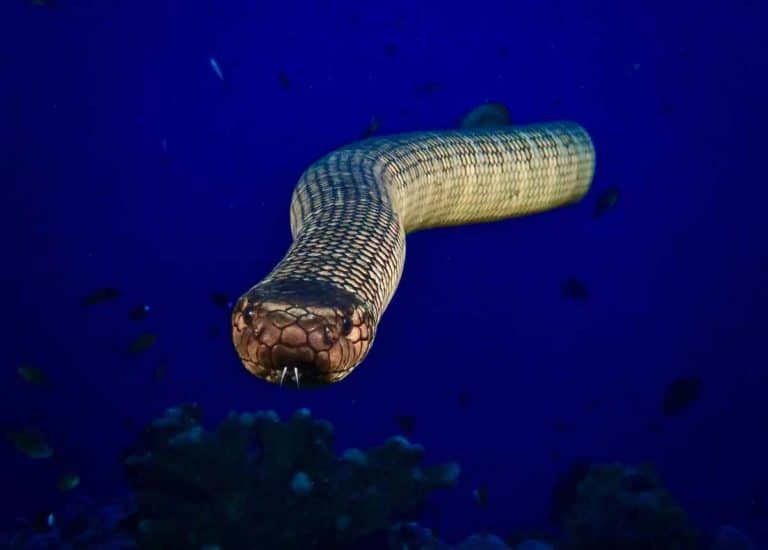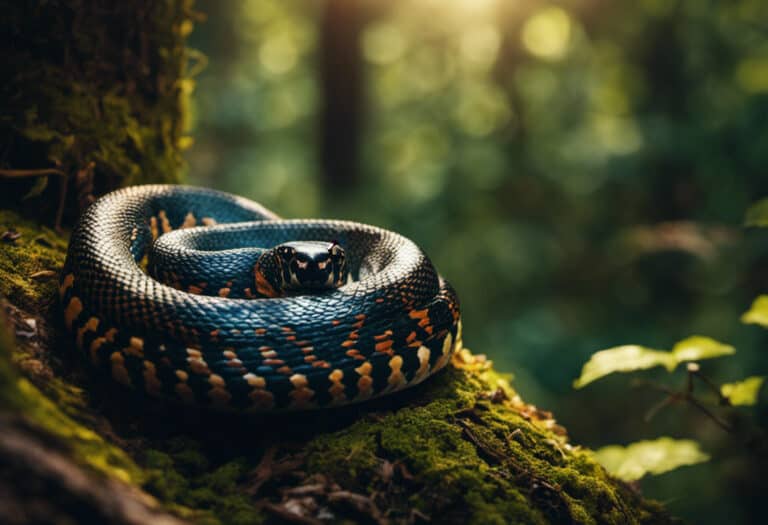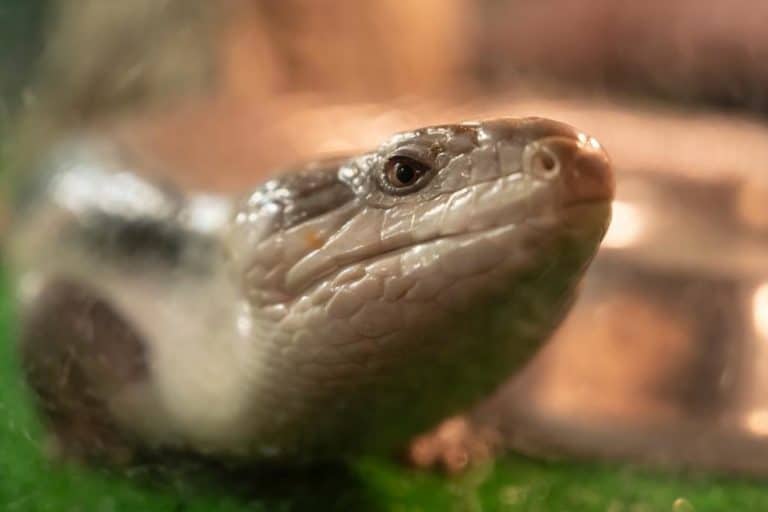Exploring Habitats: Do Copperhead Snakes Like Water?
Copperhead snakes are known for their venomous bites and are found in the Eastern or Southeastern United States. They are often associated with water sources, but do copperheads like water?
While copperhead snakes are not adapted to living in water like water snakes, they can swim on top of the water with their heads elevated above the surface.
Copperheads rarely go underwater compared to water snakes like cottonmouth snakes. They bask in the sun on rocks or logs near the water’s edge and enter the water to hunt or cross if necessary. Copperheads like to stay near water sources as they rely on external sources for hydration.
Copperheads are venomous and can bite even when underwater, so it’s best to avoid them and get out of the water if you spot one.
They use their tails to propel themselves forward and can swim at high speeds. Copperheads can stay underwater for a few minutes and prey on small amphibians, reptiles, and mammals living near water sources. It is essential to identify copperhead snakes to avoid being bitten. If there is a problem with copperheads on your property, it is best to call a professional snake removal company.
Key Takeaways:
- Copperhead snakes can swim and often live near water sources.
- Copperheads are not adapted to living underwater like water snakes.
- Copperheads rely on external sources for hydration and enter the water to hunt or cross.
- Copperheads are venomous and can bite even when they are underwater.
- If you encounter copperheads, avoiding them and getting out of the water is best.
Understanding Copperhead Snakes and Their Habitat
Copperhead snakes, also known as Agkistrodon contortrix, belong to the pit viper family and get their name from the copper-colored head, typically darker than their bodies. These venomous snakes are found in the Eastern and Southeastern United States, often in wooded areas near streams or rivers. Copperheads are not actual water snakes, but they are frequently seen near water due to their need for hydration and hunting.
Copperheads are found in various habitats, including woodlands, swamps, marshes, and rocky hillsides. They are often seen basking in the sun on rocks or logs near the water’s edge, requiring water sources for hydration and hunting. Copperheads build their nests near water sources, where the female will mate with multiple males and give birth to live young in late summer or early fall.
While copperheads can swim, they are not as proficient as other snakes. They can float on the water with their head elevated above the surface and use their tail as a rudder. However, they are not adapted to living in water like water snakes and rely on external water sources for hydration.
Despite their ability to swim, copperheads do not spend much time in the water compared to water snakes. They may enter the water to hunt or cross if necessary but prefer to stay on land. It is essential to exercise caution when swimming in bodies of water where they may be present, as copperheads are venomous and can bite underwater.
Suppose you suspect copperheads on your property. In that case, contacting a professional snake removal company is best, as attempting to remove them on your own can be dangerous. Understanding copperhead snakes and their habitat can help you be aware of their presence and take appropriate precautions to avoid potential risks.
Copperhead Snakes and Water Skills
While copperheads are good swimmers, they are less proficient than other water snakes. Copperheads are known to swim in ponds and streams, but they do not stay underwater for long periods like water snakes such as cottonmouths. They can, however, float on top of the water with their head above the surface, using their tail as a rudder to help them swim in a straight line.
Copperheads are not adapted to living in water like their aquatic counterparts, but they are often found close to water sources such as streams and rivers. They swim in these bodies of water to hunt or cross them and are most active in the summertime.
It is essential to exercise caution when swimming in bodies of water where copperheads may be present. Copperheads are venomous and can bite even while underwater. Although they cannot breathe underwater, they can stay submerged for extended periods by closing the valves in their nostrils. If you encounter a copperhead while swimming, it is best to immediately exit the water and call for professional snake removal services.
Copperhead Snakes in Aquatic Environments
Copperhead snakes are often mistaken for water snakes due to their presence near bodies of water. However, these venomous snakes do not inhabit aquatic environments. Instead, they rely on water sources such as streams, rivers, and lakes for hunting and hydration. Copperheads are commonly found in the sun on rocks or logs near the water’s edge.
While copperheads are known to be good swimmers, they rarely go underwater compared to other water snakes. They can swim on top of the water with their head elevated above the surface and use their tail as a rudder to help them swim in a straight line.
Copperheads usually have a brown, reddish-brown, or beige color and have hourglass-shaped crossbands darker than their bodies. These snakes can grow up to two to three feet long and tend to live in woodlands near streams or rivers.
It is important to note that copperheads are not aggressive but will bite if they feel threatened. Therefore, it is best to exercise caution when encountering them near water sources and to call a professional snake removal company if there is a problem with copperheads on your property.
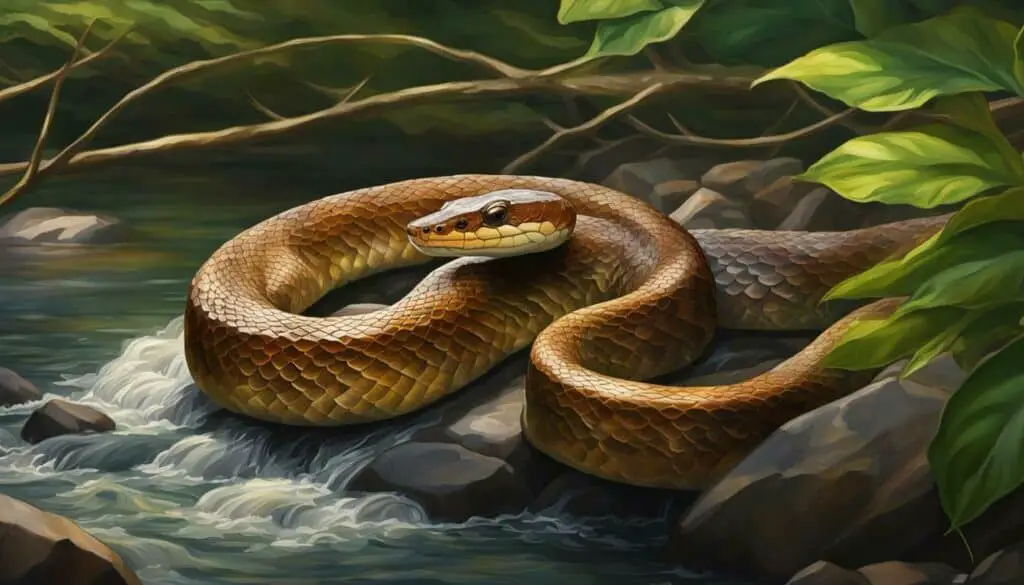
Swimming Behavior and Precautions
When it comes to swimming, copperheads are not actual water snakes. Although they are known to be good swimmers, they are not as skilled at swimming as some other snakes. Copperheads swim on top of the water with their head elevated and use their tail as a rudder. They rarely go underwater compared to other water snakes.
It is essential to exercise caution when encountering copperheads in or around bodies of water, as they are venomous and can bite even underwater. Like some snakes, copperheads can open their mouths and eat without getting water in their lungs. If you encounter a copperhead snake while swimming, it is best to calmly and slowly move away from it and call for professional assistance.
Copperhead snakes may swim if they are hunting or being chased by predators. Their swimming ability and behavior underwater can vary depending on the individual snake. Copperheads are proficient swimmers who can propel themselves forward through the water at high speeds using their long tails. They can stay submerged for a couple of minutes and will swim if there is a prey nearby.
It can be challenging to differentiate between a copperhead snake and other water snakes, but copperheads have distinct copper-colored heads and hourglass-shaped crossbands on their body. If you spot a snake while swimming, you must be aware of its presence and take precautions to prevent being bitten.
If you need to remove a copperhead snake from your property, it is best to call a professional snake removal company to avoid getting bitten. Removing a snake on your own can be dangerous and lead to serious injury. Always be cautious when swimming in bodies of water where copperheads may be present.
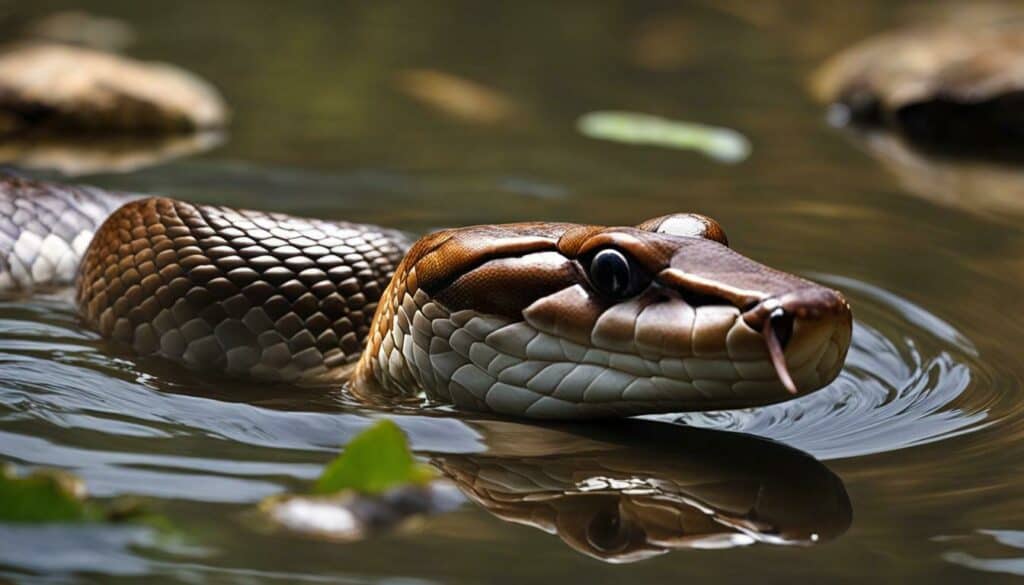
Copperhead Snakes in Aquatic Environments
Copperheads build their nests near water sources to provide a reliable food source for their young when they hatch. However, while they are often seen near bodies of water, they are not considered water snakes. Copperheads are mainly terrestrial and rely on water sources for hunting and hydration.
Copperhead snakes are adaptable in aquatic environments and can swim through ponds and streams using their tail as a rudder. They typically float on the water’s surface with their head above it. Unlike actual water snakes, copperheads are uncomfortable spending long periods in the water.
While not aquatic snakes, copperheads are often encountered near water sources. It is essential to exercise caution when engaging copperheads in these environments, as they can still deliver a nasty bite.
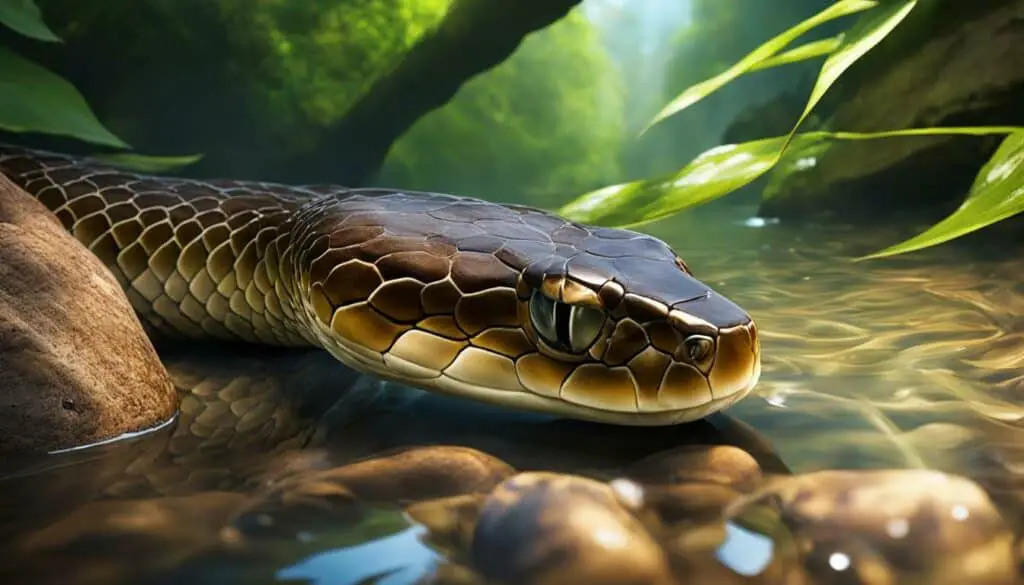
One thing to remember is that copperheads are not aggressive and will only bite if they feel threatened. This includes when they are in the water. If you spot a copperhead while swimming or near a body of water, it is best to move away and give the snake plenty of space slowly.
If you have a problem with copperheads on your property, it is best to call a professional snake removal company. Attempting to remove the snakes yourself can be dangerous and may result in injury.
Conclusion
In summary, copperhead snakes can swim and are often found near bodies of water. Although they are not adapted to living in water like water snakes, they may go into the water for hunting or to escape predators. Copperheads use their tails to propel themselves and can swim at high speeds.
It is essential to exercise caution when near bodies of water where copperheads may be present. If you encounter a copperhead, it is best to stay away and call a professional snake removal company if needed. Remember, copperheads will bite if they feel threatened, even in the water.
Understanding copperhead snake behavior and their association with water sources is crucial for safety. Stay alert and cautious when near water to avoid unwanted encounters with these slithery reptiles.
FAQ
Q: Do copperhead snakes spend a lot of time in the water?
A: While copperhead snakes can swim, they do not spend much time underwater. They prefer to stay near bodies of water but rely on them mainly for hunting and hydration.
Q: Can copperhead snakes breathe underwater?
A: No, copperhead snakes cannot breathe underwater. They must come up to the surface every few minutes to live.
Q: Are copperhead snakes aggressive in water?
A: Copperhead snakes can still bite when submerged in water, so it is best to avoid them and give them a wide berth if encountered while swimming.
Q: Do copperhead snakes build nests near water sources?
A: Female copperhead snakes often build their nests near water sources to provide a reliable food source for their young when they hatch.
Q: How many baby copperhead snakes do females typically give birth to?
A: Female copperhead snakes usually give birth to four to eight young, although some may have up to 20.
